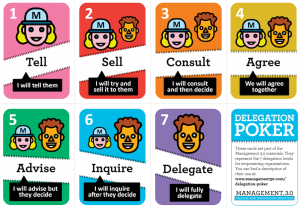I’m currently coaching a team with several stakeholders in different parts of the organization. It’s difficult to know who to talk to when decisions need to be made. The line between what the team can decide about and what the stakeholders need to be involved in is also blurry. To help create more clarity and a better collaborative environment with our stakeholders we decided to create a delegation board. The meetings we ran this week were appreciated by everybody, so I thought I would share what we did and what we learned.
Agree on the model you want to use
We decided to use the 7 levels of delegation by Jurgen Appelo to figure out where we stand with our stakeholders.
- Tell: You as the manager make the decision.
- Sell: You make the decision but you try to persuade the team to buy into it.
- Consult: You get input from the team before still making decision.
- Agree: You make a decision together with the team.
- Advise: The team makes the decision, but you try to influence it.
- Inquire: The team makes the decision and then tells you about it.
- Delegate: You offer no influence and let the team work it out.
N/A: This is not within your sphere of decision making (this was our addition)
Identify the stakeholders
We already knew who our stakeholders were. At first we considered only including the stakeholders whose opinions we were unsure of, not those we met with almost daily. As we discussed the different areas and topics we wanted to cover we decided to include them all.
Create a list of important areas to discuss
We wrote down all the areas where we need to make big decisions (this really is anything, from architecture to timelines to UI). We started out with the ones that several stakeholders were interested in. We then included the areas where we thought stakeholders wanted to take part in making the decisions. Finally, for good measure, we even included the ones where we were positive we knew which stakeholders to talk to and at what level.
Hold the meeting(s)
We scheduled several meetings with different groups of stakeholders. The meetings were all very similar. We put up a grid on the board, with the work areas along the y-axis, and stakeholders along the x-axis, as well as an explanation of the 7 levels of delegation.
The meetings looked something like this:
- Introduce the purpose of the meeting: Great collaboration between the team and stakeholders.
- Explain the delegation model, and go through the list of areas to discuss.
- Set the stage: This is a time limited agreement, with an expiration date. Think of a situation where the team might need to make a decision that you think is strategically important, what would you want your level of involvement to be?
- Ask all the stakeholders to each take a marker and fill out their column.
- Discuss the results and come to working agreements.
The first 4 steps took about 5-10 minutes of the meeting. Next we went through each area, row by row to discuss the numbers on the board and what they meant. Some numbers were adjusted up and others down. Most importantly we came up with a list of working agreements based on these discussions. We now knew how we could work day to day with each of the stakeholders. We were also able to reduce the number of involved stakeholders in each area, down to what was really needed. In some cases we decided to set up a follow up meeting to discuss specific areas, and how we would work together.
We rounded out the meeting with a ROTI (return on time investment) vote so we could make improvements to the format for our next meeting. We were glad to see that our stakeholders had ROTI scores between 4 and 5 out of 5, and that they were on board with us running this exercise again in the future.
What we learned
- List all activities! We were bad at guessing what level of involvement our stakeholders wanted, even in areas we thought didn’t need discussion.
- Include all stakeholders! We got valuable feedback from each of our discussions, especially from stakeholders we work with all the time. It’s easy to take the way we work for granted when you meet frequently, but it doesn’t mean you can’t benefit from some structured time to make sure you’re all on the same page.
- Set the stage! Make it clear that the delegation scores are based on the team needing to make a “big decision” in each area.
We got honest thoughtful feedback, and we were able to discuss our needs given the amount of delegation we received. We’re hopeful that by using this delegation board we’ll be able to foster a collaborative environment based on mutual understanding.
Get in touch via my homepage if you have questions or comments!






I like this technique, I can see this same situation arising with our clients, pre and post contract. This would provide a great basis of understanding upon which to progress with. Thank you for sharing.
Sure thing!
thanks Yassal,
your report helped me to prepare a DP meeting for a project I am working in.
Great support!
Glad to hear it!